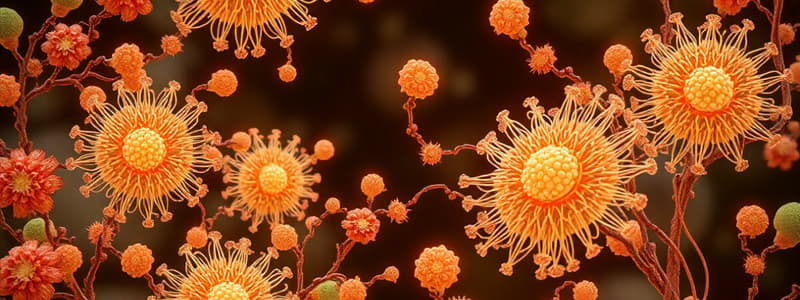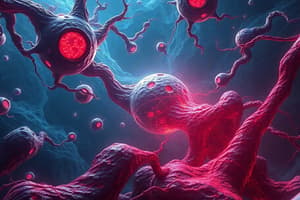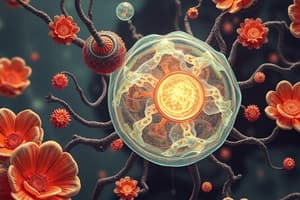Podcast
Questions and Answers
Which process is indicated by the presence of FITC labeled Annexin V binding to phosphatidylserine (PS)?
Which process is indicated by the presence of FITC labeled Annexin V binding to phosphatidylserine (PS)?
- Mitosis
- Autophagy
- Necrosis
- Apoptosis (correct)
In the FACS plot, which quadrant represents live cells that are negative for both Annexin V and PI?
In the FACS plot, which quadrant represents live cells that are negative for both Annexin V and PI?
- Left upper quadrant
- Left lower quadrant (correct)
- Right upper quadrant
- Right lower quadrant
What does the presence of a double membrane structure indicate in the context of cellular processes?
What does the presence of a double membrane structure indicate in the context of cellular processes?
- Autophagy (correct)
- Mitosis activity
- Cellular necrosis
- Apoptotic bodies
Which statement correctly describes how the interpretation of a FACS plot changes when treating cells with chemotherapy?
Which statement correctly describes how the interpretation of a FACS plot changes when treating cells with chemotherapy?
What is the primary effect of the inability to cleave pro-caspase 9 in the studied cell line?
What is the primary effect of the inability to cleave pro-caspase 9 in the studied cell line?
Which mechanism best explains the action of the new drug developed for aggressive breast cancer?
Which mechanism best explains the action of the new drug developed for aggressive breast cancer?
Which statement accurately describes how excessive apoptosis can lead to disease?
Which statement accurately describes how excessive apoptosis can lead to disease?
How does dysregulation of apoptosis often manifest in cancer?
How does dysregulation of apoptosis often manifest in cancer?
What role does cytochrome c play in the intrinsic pathway of apoptosis?
What role does cytochrome c play in the intrinsic pathway of apoptosis?
What is the primary function of phagolysosomes in the context of cellular processes?
What is the primary function of phagolysosomes in the context of cellular processes?
What signifies that a cell is undergoing death based on the authors' explanation?
What signifies that a cell is undergoing death based on the authors' explanation?
Which statement best describes the role of the signals mentioned by the authors?
Which statement best describes the role of the signals mentioned by the authors?
What is meant by the term 'coryolysis' as mentioned in the content?
What is meant by the term 'coryolysis' as mentioned in the content?
In the context of cell death, what is the significance of the receptors mentioned?
In the context of cell death, what is the significance of the receptors mentioned?
Which process occurs as a result of the activation of specific intracellular pathways?
Which process occurs as a result of the activation of specific intracellular pathways?
What purpose do the authors aim to achieve with their illustration regarding cell death?
What purpose do the authors aim to achieve with their illustration regarding cell death?
How do the authors depict the concept of recycling in cellular processes?
How do the authors depict the concept of recycling in cellular processes?
What is the primary function of apoptosis?
What is the primary function of apoptosis?
Which of the following correctly contrasts apoptosis and necrosis?
Which of the following correctly contrasts apoptosis and necrosis?
How do pro-apoptotic proteins function?
How do pro-apoptotic proteins function?
Which best describes autophagy in relation to apoptosis?
Which best describes autophagy in relation to apoptosis?
What differentiates primary literature from secondary literature?
What differentiates primary literature from secondary literature?
What can result from dysregulation of apoptosis?
What can result from dysregulation of apoptosis?
For which purpose would primary literature be most suitable?
For which purpose would primary literature be most suitable?
Which statement is true regarding apoptosis during development?
Which statement is true regarding apoptosis during development?
What role does Annexin V-FITC play in the identification of apoptotic cells?
What role does Annexin V-FITC play in the identification of apoptotic cells?
In flow cytometry, what does the left lower quadrant represent?
In flow cytometry, what does the left lower quadrant represent?
What does the term 'apoptosis' refer to?
What does the term 'apoptosis' refer to?
What role does Bcl-2 play in the apoptosis process?
What role does Bcl-2 play in the apoptosis process?
Why does only dead cells take up PI in flow cytometry?
Why does only dead cells take up PI in flow cytometry?
What happens as a result of mutations in Bax?
What happens as a result of mutations in Bax?
Which protein is primarily responsible for activating caspase 9?
Which protein is primarily responsible for activating caspase 9?
What occurs to phosphatidylserine (PS) during apoptosis?
What occurs to phosphatidylserine (PS) during apoptosis?
How is fluorescent intensity measured in flow cytometry?
How is fluorescent intensity measured in flow cytometry?
What is the main function of executioner caspase 3?
What is the main function of executioner caspase 3?
What does the right upper quadrant represent in flow cytometry results?
What does the right upper quadrant represent in flow cytometry results?
Which statement about p53 is true?
Which statement about p53 is true?
What role does the FAS ligand play in apoptosis?
What role does the FAS ligand play in apoptosis?
Which of the following statements correctly describes the cleavage involved in apoptosis?
Which of the following statements correctly describes the cleavage involved in apoptosis?
How do IAPs affect the apoptosis process?
How do IAPs affect the apoptosis process?
What is the consequence of mutations in phosphatidylserine?
What is the consequence of mutations in phosphatidylserine?
Flashcards
Apoptosis
Apoptosis
A programmed process of cell death that is essential for normal development and tissue homeostasis.
Necrosis
Necrosis
Uncontrolled cell death caused by injury, toxins, or lack of oxygen, leading to inflammation and tissue damage.
Autophagy
Autophagy
A self-eating process where cells break down and recycle their own components, providing nutrients and energy under stress.
Intrinsic Apoptosis Pathway
Intrinsic Apoptosis Pathway
Signup and view all the flashcards
Extrinsic Apoptosis Pathway
Extrinsic Apoptosis Pathway
Signup and view all the flashcards
Caspases
Caspases
Signup and view all the flashcards
Pro-apoptotic Proteins
Pro-apoptotic Proteins
Signup and view all the flashcards
Anti-apoptotic Proteins
Anti-apoptotic Proteins
Signup and view all the flashcards
Phagolysosomes
Phagolysosomes
Signup and view all the flashcards
Corryolysis
Corryolysis
Signup and view all the flashcards
Cell Death Signals
Cell Death Signals
Signup and view all the flashcards
What are the signals for cell death?
What are the signals for cell death?
Signup and view all the flashcards
Intracellular Pathways
Intracellular Pathways
Signup and view all the flashcards
Enzymes
Enzymes
Signup and view all the flashcards
Why are specific signals important for cell death?
Why are specific signals important for cell death?
Signup and view all the flashcards
Programmed Cell Death
Programmed Cell Death
Signup and view all the flashcards
Annexin V-FITC Staining
Annexin V-FITC Staining
Signup and view all the flashcards
Propidium Iodide (PI) Staining
Propidium Iodide (PI) Staining
Signup and view all the flashcards
FACS Plot Interpretation
FACS Plot Interpretation
Signup and view all the flashcards
Chemotherapy Drug Effects
Chemotherapy Drug Effects
Signup and view all the flashcards
Fas Ligand Binding
Fas Ligand Binding
Signup and view all the flashcards
DISC Complex Formation
DISC Complex Formation
Signup and view all the flashcards
Pro-caspase 9 Cleavage
Pro-caspase 9 Cleavage
Signup and view all the flashcards
Apoptosome Formation
Apoptosome Formation
Signup and view all the flashcards
Bcl-2 Overexpression
Bcl-2 Overexpression
Signup and view all the flashcards
Phosphatidylserine (PS)
Phosphatidylserine (PS)
Signup and view all the flashcards
Annexin V
Annexin V
Signup and view all the flashcards
Propidium Iodide (PI)
Propidium Iodide (PI)
Signup and view all the flashcards
Flow Cytometry
Flow Cytometry
Signup and view all the flashcards
FACS Plot (Fluorescence activated cell sorting plot)
FACS Plot (Fluorescence activated cell sorting plot)
Signup and view all the flashcards
Bcl-2
Bcl-2
Signup and view all the flashcards
Bax
Bax
Signup and view all the flashcards
Bim
Bim
Signup and view all the flashcards
Cytochrome c
Cytochrome c
Signup and view all the flashcards
FAS ligand
FAS ligand
Signup and view all the flashcards
IAP
IAP
Signup and view all the flashcards
p53
p53
Signup and view all the flashcards
Study Notes
Apoptosis and Cell Death Mechanisms
- Apoptosis is programmed cell death, crucial for development and maintaining cellular health.
- Apoptosis is an energy-dependent process characterized by specific morphological changes.
- Apoptosis pathways include intrinsic (internal cellular stress) and extrinsic (external signals).
- Apoptosis doesn't induce inflammation.
- Cells shrink, condense, and form apoptotic bodies, which are then engulfed.
Learning Objectives
- Students should compare and contrast apoptosis, necrosis, and autophagy by understanding cellular changes.
- Students should explain why apoptosis is a normal process and provide examples.
- Students should learn the intrinsic and extrinsic apoptosis pathways.
- Students should explain how pro- and anti-apoptotic proteins function.
- Students should describe how necrosis and apoptosis dysregulation lead to diseases and give examples.
Disclaimer
- The lecture format will be different, prioritizing interactive activities.
- Lecture slides are provided but will be explained minimally.
- Students must use supplemental articles to answer activity questions.
- Class notes must be submitted for homework in a specific format.
Activity 1 – Articles Review
- Articles aim to discuss types of apoptosis, benefits, and how different pathways function.
- Different articles target different audiences (general vs. science-focused).
- One article may be easier to understand based on simpler terminology, aiding in clarity for a wider range of learners.
- Primary literature presents original findings, while secondary summarizes existing research.
Activity 2 – Apoptosis, Necrosis, and Autophagy
- Apoptosis: Programmed cell death, no inflammation, occurs when cell function is complete or the cell is misbehaving. Examples include embryonic development and cancer.
- Necrosis: Uncontrolled and passive cell death from injury (lack of oxygen, physical trauma), resulting in inflammation and releasing cell components. An example is a burn victim.
- Autophagy: Cellular self-digestion, maintaining cell health, occurring when there is starvation - cell breakdown and recycling of components for new cell function/repair.
Activity 2 - Illustration and Signaling
- The illustration metaphorically compares the cell's processes to daily life objects, like a cellular signal.
- The author aims to describe cell death pathways' complexity and interplay of external and internal signals in cell processes.
- Authors use analogies, such as cell communication or the signal transmission, to convey the pathways and steps involved.
Activity 2 - Proteases & Cell Death in 1996
- ICE-like proteases are now more commonly called caspases.
- Caspase-1 is part of this proteolytic family.
Apoptosis, Necrosis, and Autophagy (Continued)
- Morphological features (cell size, cytoplasmic density, organelle distribution): used to distinguish between apoptosis, necrosis, and autophagy.
- Morphological features for each - cell death process
- Apoptosis: smaller, dense cytoplasm, condensed organelles
- Necrosis: large, swollen cells
- Autophagy: unchanged cytoskeleton, vacuoles
- Process importance: Understanding differences is vital for applying appropriate interventions or treatment.
Additional Activity 2 Information
- This section includes descriptions of each process, how to distinguish them, and why these processes matter.
- Key morphological changes in each process to aid in identification
- Apoptosis: cell shrinkage, chromatin condensation
- Necrosis: cell swelling, loss of membrane integrity
- Autophagy: compartmentalization, organelles surrounded by membranes.
Activity 3 – Cell Death/Flow Cytometry
- PS(phosphatidylserine) flips to the outer membrane, making the cell green in labeling; PI or 7AAD uptake by dead cells gives pink color
- This helps distinguish dead from living cells and early and late apoptotic/necrotic stages through cellular staining.
- Quantify apoptotic and necrotic cells using FACs (fluorescence activated cell sorter) data/plots
Activity 3 – Cell Death/Flow Cytometry (Continued)
- Flow cytometry uses fluorescent dyes (annexin V, PI, 7AAD) to categorize cells based on their apoptosis status.
- Analyzing flow cytometry graphs helps clinicians and researchers understand cell death populations and stages.
Activity 3- Organelle Identification
- Microscopic (EM/Electron Microscopy) images depict organelles within a cell, aiding cellular processes that involve the degradation and recycling of organelles.
- Autophagy shows organelles within double membranes, used for cell digestion and component recycling/regeneration.
Activity 4 – Dysregulated Apoptosis
- Excessive apoptosis can lead to diseases like AIDS, type 1 diabetes, Alzheimer's, Parkinson's.
- Excessive apoptosis is seen when cells "die too quickly" thus affecting function.
- Insufficient apoptosis leads to uncontrolled cell growth and cancer (overexpression of Bcl2).
Muddiest Point
- The student found the intrinsic pathway description to be challenging.
Studying That Suits You
Use AI to generate personalized quizzes and flashcards to suit your learning preferences.




